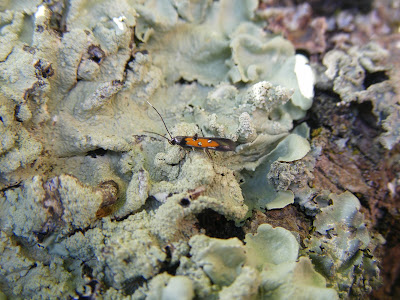 |
| Linden Bark Borer, Chrysoclista linneella |
I tend to accumulate pictures of plants and animals unfamiliar to me for identification at a later stage. Some are easy, some hard and some are downright impossible to pin down. Take the little guy above. I knew it was a moth, just about, and a bit of research gave me an idea it was a member of the Cosmopterigidae. Further mining of databases reveled this Cosmet moth to be Chrysoclista linneella (1), The Linden Bark Borer (or, more appealing still, Linaeus' Spangle Wing). A great thank you is due to Angus Tyner of the MothsIreland Project for confirmation of this identity.
 |
| Linden Bark Borer, Chrysoclista linneella |
However, once had found an identity, the reason it had been so hard to figure out became apparent: C. linneella has never been recorded in the Republic of Ireland (2). It may be even unrecorded in the whole island of Ireland as only one record exists, from Hollwood in Co. Down from 1855 and this is considered doubtful (3).
 |
| Linden Bark Borer, Chrysoclista linneella |
C. linneella has a holarctic distribution, being found in most of Europe, Scandinavia, Russia and Britain, as well as North America where it was first reported as an introduction in 1928 (4). The c. 11 mm adults have metallic blotches against a vibrant orange wing and are visible from May to September (1). The larvae feed under the back of linden trees (Tilia spp.) and can cause considerable damage to plantations (4).
The specimen pictured was spotted on the bark of a linden tree in July 2010 in an area close to a large container port. This may have been a point of access for the moth.
References:
- Koster, 2002. Tijdschrift voor Entomologie 145 pp. 103-114
- Bond et al., 2006. An Annotated Checklist of the Irish Butterflies and Moths (Lepidoptera)
- Bond, K.G.M, (2009). Microlepidoptera of Northern Ireland Check-list. Northern Ireland Environment Agency Research and Development Series No. 09/02 p. 200
- Majka, 2005. Canadian Entomologist 137 pp. 620–621
No comments:
Post a Comment